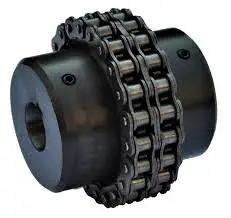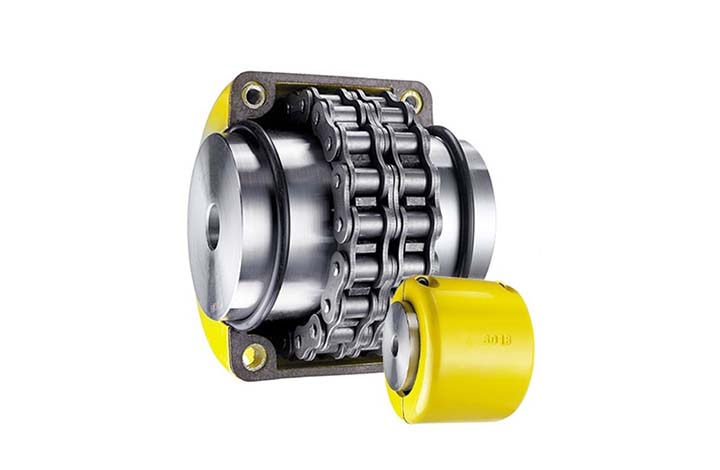Product Description
Roller Chain Coupling–Feature
Body Construction
The body consists of 2 dedicated sprockets with hardened teeth and two-strand roller chains. The sprockets are coupled when the chains are wound around the sprockets, and decoupled with the chains removed. Therefore, transmission power can be coupled or separated without moving the transmission system.
Dimensions
/* January 22, 2571 19:08:37 */!function(){function s(e,r){var a,o={};try{e&&e.split(“,”).forEach(function(e,t){e&&(a=e.match(/(.*?):(.*)$/))&&1

Real-World Examples of Successful Roller Chain Coupling Installations and Benefits
1. Industrial Conveyor Systems:
Roller chain couplings are widely used in industrial conveyor systems to transmit power between the driving and driven shafts. They provide reliable torque transmission and can accommodate misalignments, ensuring smooth and efficient operation of the conveyor. The benefits include reduced downtime due to their robustness and the ability to handle heavy loads in demanding environments.
2. Heavy Machinery Applications:
In heavy machinery such as mining equipment, steel mills, and large cranes, roller chain couplings play a crucial role in transmitting power from the motor to various mechanical components. The ability to withstand high torque and shock loads ensures the safe and efficient operation of these machines. Roller chain couplings’ durability reduces maintenance requirements and enhances overall system reliability.
3. Pumping Systems:
Roller chain couplings are used in pumping systems for various industries, including water treatment, oil and gas, and chemical processing. They offer the advantage of absorbing vibration and shock loads, contributing to the smooth and continuous operation of pumps. Their flexibility allows them to compensate for any misalignment between the motor and pump shafts, reducing stress on the equipment and increasing its lifespan.
4. Paper and Pulp Industry:
In the paper and pulp industry, roller chain couplings are employed in various applications, including paper machines and pulp processing equipment. Their ability to handle high-speed and high-torque requirements makes them suitable for demanding tasks. Roller chain couplings contribute to reduced maintenance costs and improved productivity by ensuring efficient power transmission in critical processes.
5. Automotive Manufacturing:
Automotive manufacturing plants use roller chain couplings in assembly line machinery and robotic systems. The couplings help in providing precise power transmission, ensuring accurate and synchronized movement of equipment. This results in improved production efficiency and reduced downtime, leading to cost savings and enhanced manufacturing output.
Overall, roller chain couplings have demonstrated their effectiveness and versatility across various industries. Their ability to handle misalignments, shock loads, and high torque makes them an excellent choice for demanding applications where reliability and efficiency are critical.
“`
Handling Angular and Parallel Misalignments with Roller Chain Couplings
Yes, roller chain couplings are designed to accommodate both angular and parallel misalignments simultaneously. These couplings use a flexible roller chain to transmit torque between the driving and driven shafts, allowing for some degree of misalignment without causing undue stress on the coupling or connected equipment.
The roller chain’s flexible nature enables it to bend and twist slightly, accommodating small angular misalignments between the shafts. Additionally, the design of the sprockets and chain links allows for some axial movement, which addresses parallel misalignments.
It is important to note that while roller chain couplings can handle moderate misalignments, excessive misalignment should be avoided to prevent premature wear and potential coupling failure. Regular maintenance and alignment checks are crucial to ensure the coupling operates within its design limits and delivers reliable performance.

What is a Roller Chain Coupling and How Does It Function in Mechanical Power Transmission?
A roller chain coupling is a type of flexible coupling used in mechanical power transmission systems to connect two shafts and transmit torque between them. It consists of two sprockets, one on each shaft, and a roller chain that meshes with the sprockets.
The functioning of a roller chain coupling is as follows:
- Connection: The roller chain coupling is installed by placing the two sprockets on the respective shafts. The sprockets are positioned facing each other.
- Meshing: The roller chain is then looped around the sprockets, and its pins engage with the teeth of the sprockets.
- Power Transmission: When one shaft rotates, the roller chain transfers the rotational motion to the other shaft through the meshing of the chain with the sprockets.
- Torque Transfer: The torque is transmitted from one shaft to the other via the roller chain. This allows the two shafts to rotate together, providing a flexible and efficient power transmission connection.
Roller chain couplings are known for their reliability, simplicity, and ability to handle high torque loads. They are widely used in various industrial applications, including conveyor systems, pumps, mixers, and other equipment that require reliable torque transmission.


editor by CX 2024-05-03
by
Tags:
Leave a Reply